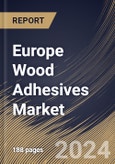The application of wood adhesives is often more straightforward and efficient compared to traditional mechanical fastening methods. Adhesives eliminate the need to drill holes or use additional hardware, streamlining the assembly process. This efficiency is advantageous in industries with high production volumes, contributing to cost-effectiveness and faster turnaround times. The use of these allows for the creation of visually appealing products.
The absence of visible fasteners on the surface contributes to a clean and aesthetically pleasing finish. This is particularly important in industries such as furniture manufacturing and automotive interiors, where the visual appeal of the final product significantly influences consumer preferences. The rise of engineered wood products, including plywood, particleboard, and laminated veneer lumber, has further propelled the adoption of wood adhesives.
According to the UK Government, with its highly linked supply chains and substantial demand for UK-built cars throughout the region, the European region has benefited the U.K. automotive sector with its varied products, encompassing volume, premium, and niche vehicles. The UK is home to several luxury car manufacturers that emphasize high-quality interiors. Luxury car manufacturers in the UK significantly emphasize craftsmanship and attention to detail. Thus, all these factors will uplift the regional market’s expansion in the coming years.
The Germany market dominated the Europe Wood Adhesives Market by Country in 2022 and would continue to be a dominant market till 2030; thereby, achieving a market value of $646.2 million by 2030. The UK market is exhibiting a CAGR of 6.4% during (2023 - 2030). Additionally, The France market would experience a CAGR of 8.1% during (2023 - 2030).
Based on Application, the market is segmented into Furniture, Flooring, Housing Components, Doors & Windows and Others. Based on Substrate, the market is segmented into Particle Board (PB), Solid Wood, Oriented Strand Board (OSB), Plywood, Medium-Density Fiberboard (MDF), High-Density Fiberboard (HDF), and Others. Based on Product, the market is segmented into Urea-Formaldehyde (UF), Melamine Urea-Formaldehyde (MUF), Phenol-Formaldehyde (PF), Isocyanates, Polyvinyl Acetate (PVA), Polyurethane and Soy-based. Based on countries, the market is segmented into Germany, UK, France, Russia, Spain, Italy, and Rest of Europe.
List of Key Companies Profiled
- DuPont de Nemours, Inc.
- Akzo Nobel N.V.
- 3M Company
- Henkel AG & Company, KGaA
- Ashland, Inc.
- H.B. Fuller Company
- Sika AG
- Bostik S.A. (Arkema S.A.)
- Pidilite Industries Ltd.
- Jubilant Industries Limited (Jubilant Bhartia Group)
Market Report Segmentation
By Application (Volume, Kilo Tonnes, USD Billion, 2019-2030)- Furniture
- Flooring
- Housing Components
- Doors & Windows
- Others
- Particle Board (PB)
- Solid Wood
- Oriented Strand Board (OSB)
- Plywood
- Medium-Density Fiberboard (MDF)
- High-Density Fiberboard (HDF)
- Others
- Urea-Formaldehyde (UF)
- Melamine Urea-Formaldehyde (MUF)
- Phenol-Formaldehyde (PF)
- Isocyanates
- Polyvinyl Acetate (PVA)
- Polyurethane
- Soy-based
- Germany
- UK
- France
- Russia
- Spain
- Italy
- Rest of Europe
Table of Contents
Companies Mentioned
- DuPont de Nemours, Inc.
- Akzo Nobel N.V.
- 3M Company
- Henkel AG & Company, KGaA
- Ashland, Inc.
- H.B. Fuller Company
- Sika AG
- Bostik S.A. (Arkema S.A.)
- Pidilite Industries Ltd.
- Jubilant Industries Limited (Jubilant Bhartia Group)








